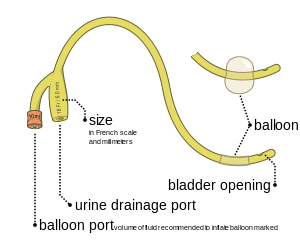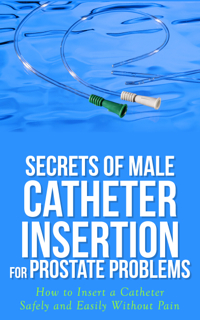
An Indwelling Foley Catheter Is Often Used for Prostate Problems

An indwelling foley catheter is a type of catheter designed to stay inside your bladder for a period of time. As such it is used after prostate cancer surgery or when your prostate blocks and you can't void your urine.
It is passed in through your penis through your prostate and into the bladder. It is designed to remain inside you for a period of time. It is made of a flexible plastic tube that makes insertion possible.
Catheters come in different shapes at both ends depending on its use. Long term use requires that the inserted tip be held in place while inside the bladder and not be easily removed or dislodged while sleeping or moving.
This is done by being able to make a little balloon on the end by pumping it up from the external end that has two openings, one for that function and one for the urine to exit.
When inflated, the balloon keeps the catheter securely in place. They are called Foley catheters and are often used for patients in hospitals who need a catheter put in place for a longer period of time.
These Foley catheters are then attached to another flexible tube from the external end that goes to a plastic bag to collect the urine, holding about a liter or quart. They can be attached to a device beside the bed in a hospital or to your leg with a strap so you can walk around.
After prostate surgery the indwelling Foley catheter is used so urine can flow while healing takes place. It is used for both prostate cancer surgery and enlarged prostate (BPH) surgery like TURP surgery where part of the inside of the prostate is removed.
Indwelling Foley Catheter Types
Catheters come in different lengths for males and females and in different thicknesses or gauges (diameters). Thinner ones are used for children and thicker ones for long term use so that they do not clog with debris or blood clots.
A male catheter is longer than a woman’s because it has to travel through the penis to get to the bladder. So male catheters are about 12 to 16 inches long.
For surgical uses the Foley catheters are probably at the thicker sizes - above 16 gauge - to allow blood to escape without clogging the tube. For most intermittent uses of a catheter a 12 or 14 gauge is adequate and far more comfortable to insert.
If you have had a Foley catheter put in place for an enlarged prostate that blocked, please read up on what to do for a prostate attack. It is often enough to just drain the bladder and then you can remove the catheter. They will usually want to leave it in place for days or weeks but in my experience this is overkill.
If you can find what triggered the prostate attack you can then avoid doing the same thing - usually it is a food or supplement that is not positive for you, or an anti-histamine or other medication that is the culprit.
I would remove the indwelling foley catheter as soon as possible if it is in there for a prostate attack and not a surgery. If you do not feel you can find out what triggered the reaction, then you will adapt to wearing the catheter and drain bag. To me I have found that 99% of the time, after removing the catheter, I am able to void OK.
Catheter Prostate Kit
Here is a list of items to create the minimal Prostate Kit. You really won’t need the optional items, but I list them in case you can’t find the coude catheter: SpeediCaths. If you want other less expensive catheters, go here: Other Catheters
Minimum Prostate Kit:
- 1 SpeediCath catheter lubricated: SpeediCath Coudé Intermittent Catheters or Straight-Tip SpeediCath. Choose 12 gauge 14” (#28492 - 12 FR, 14" Length) catheter for men. Buy several so that you have back-ups for the car, home, work, travel bag, etc. 12 gauge is the thickness of the tube. If you can't get 12s then 14s are ok as well but not quite as thin. 10s are too thin.
- 6– 10 Alcohol Prep Pads. You can get 200 for a few bucks.
- Xylocaine (very optional): Xylocaine Ointment Tube or Lidocaine With SpeediCath, you really do not need these, but if you are worried, then get some.
- KY jelly (also very optional)
- A plastic ziplock bag to hold all the items together as your emergency prostate kit.
For home use:
- The same kit as described above, but you can substitute a bottle of alcohol with Kleenex tissues that you wet for sterilizing in place of the Alcohol Prep Pads.
- Include 2 towels.
Tip: Add a SpeediCath Coudé Intermittent Touchless Catheter to your first aid kit.
IMPORTANT
If you are having troubles inserting then it may be best to go to your emergency at your hospital!
In case you can't here is what to try.
In the very rare case that a lubricated catheter is unable to pass through the prostate using all the above techniques, Use a higher gauge one: if a 12 did not work, then use a 14. If 14 did not work, use a 16.
This is contrary to what you think that a thinner one would be easier to succeed. The problem is that it is not strong enough to push through your enlarged prostate. A wider one will do the trick!
Or if you have tried a 14 or 16 gauge and they haven't worked then dropping down to a 12 or 10 may be successful.
Make sure the blue line is pointing upwards so the coude tip is up and you will be able to push a little firmer. Use some Xylocaine before inserting as described earlier.
First Choice:
SpeediCath Coudé Intermittent Touchless CatheterSpeediCath Coudé Intermittent Touchless Catheter
---------------------
Others:
That's still a soft catheter.
Another option is a stiffer one:
But the size is the key when you have problems getting through. That is why it is wise to have a bigger size as a Plan B just in case.
Go from Indwelling Foley Catheter to Types of Catheters
Go to Acute Urinary Retention
Got a Question or Comment about your Prostate Health?
This is the place to post them because I get them immediately.
I like to share them and the answers I provide so others can benefit too.
Your email is kept completely confidential. If you want to be notified when the question is answered, please make sure to add your email address. I don't collect or store these emails after they are used to send you your answer, and they are not posted with your question.
What Other Visitors Have Asked or Said
Click below to see contributions from other visitors to this page...
Foley follies, more unnecessary infections, injuries, pain and abuse
Urinary (Foley) catheters are the leading cause of hospital infections. Per studies overuse of Foley catheters is estimated at 21% to 50%. Continued inappropriate …
Massage therapy contraindicated?
I am a massage therapist who has a prospective client with a foley catheter. What are the contraindications to massage I should be aware of?
------------- …
The Long-term Care for Indwelling Catheters Requiring Frequent Flushing
This post is from a man generously sharing his insights and experience about indwelling catheters.
For any readers new to having to live with this, …
Ron, I'm Creating This Natural Health Book - May I Post Links To Your Site ?
Two years ago, sharing my love of natural nutrition from the natural soil I produce from local plant sources with a lady friend in a Seattle community …
Parkinsons, enlarged prostrate and foley catheter
My dad has been catheterized most of the time since March 2015, after he was lying on the floor for nearly 3 days in his home. He has underlying Parkinsons …
How to install a Foley catheter
I just finished reading two of your books on Kindle. The one where you talk about catheters doesn't explain how to put in a Foley. Is installation different …
Sleep Secrets by the author of this website.

Healthy Prostate:
The Extensive Guide To Prevent and Heal Prostate Problems Including Prostate Cancer, BPH Enlarged Prostate and Prostatitis
Get all the info on this site plus much much more:
• extensive guide
• searchable content
• live clickable links
• organized flow of content
• product suggestions and how to lists
• reference links
• AND GET VERY IMPORTANT INFO NOT ON THIS SITE...







